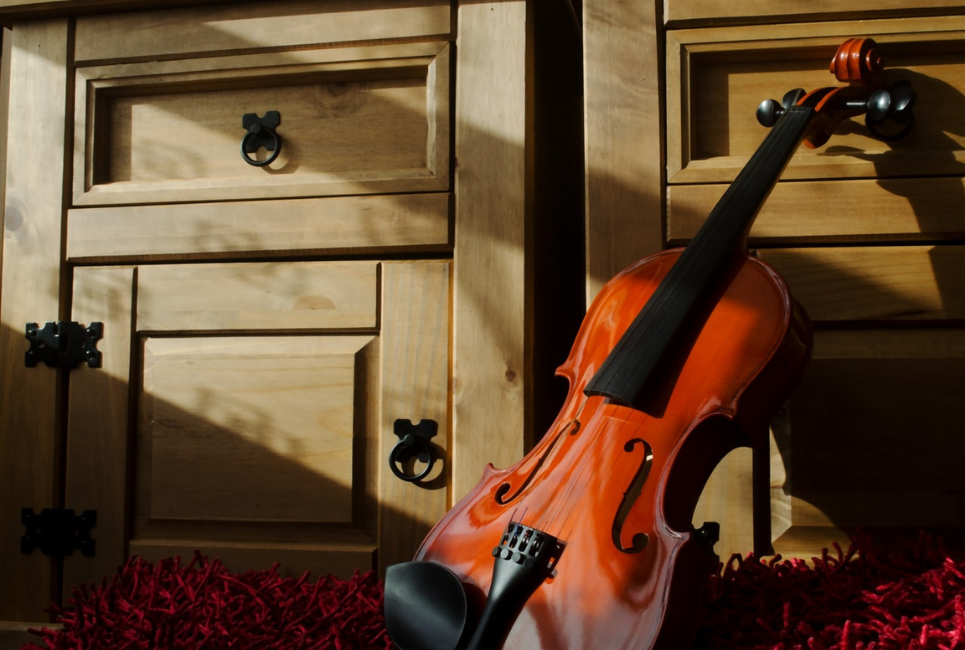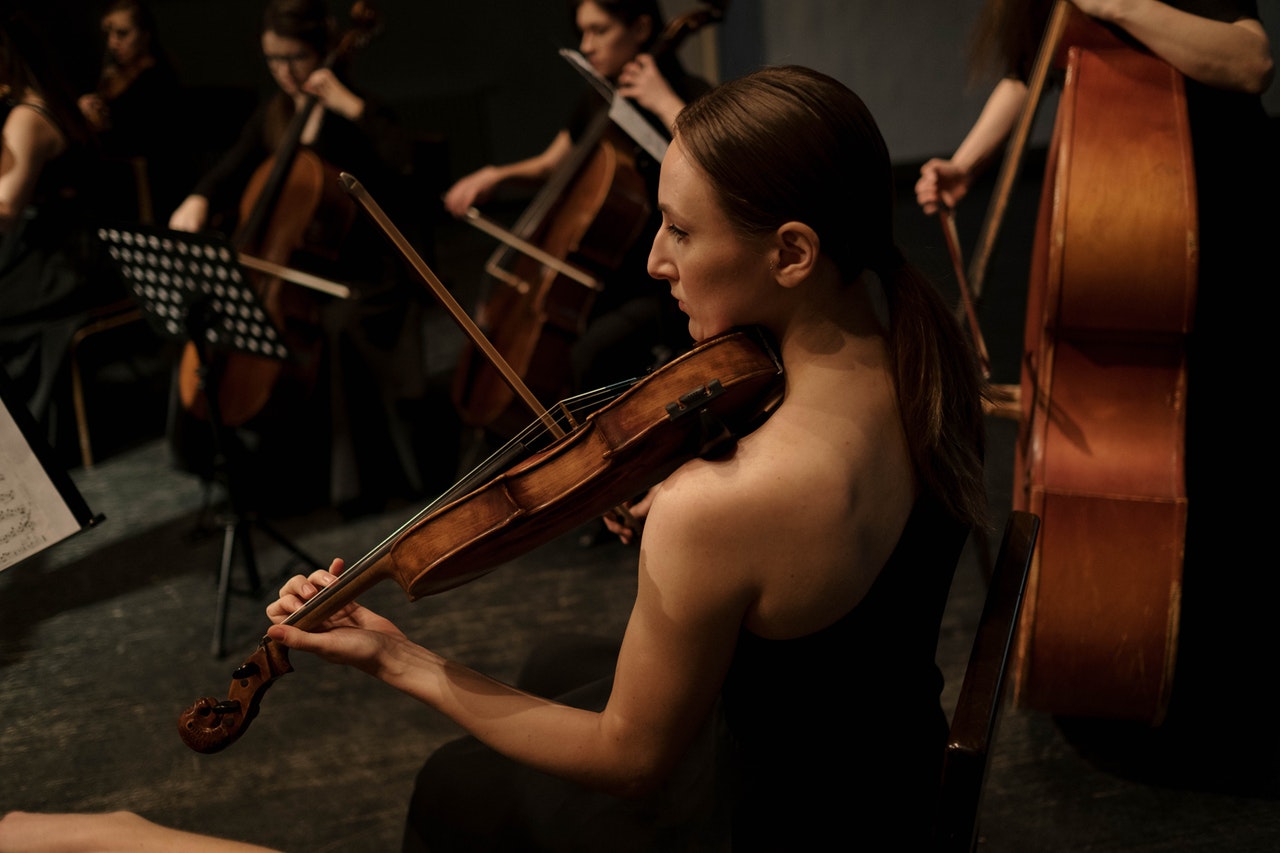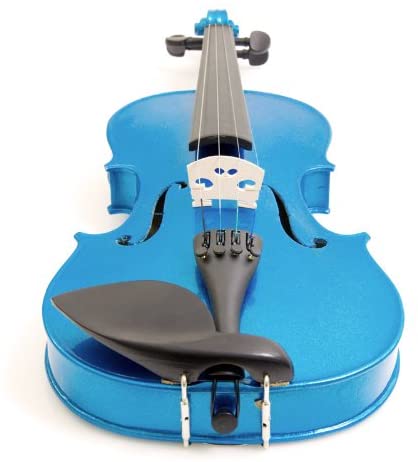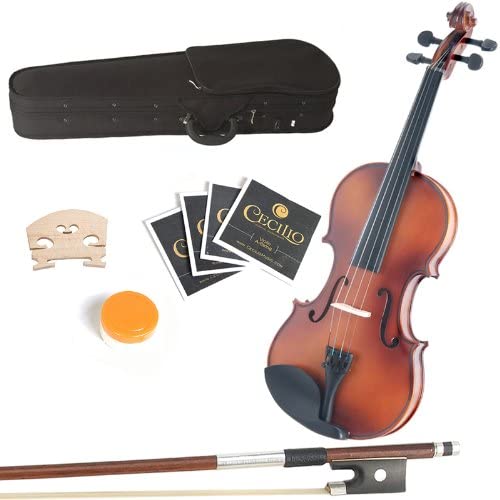- How to Find the Best 5 String Violins - April 21, 2022
- How to Hold a Violin Bow - April 21, 2022
- How to Hold a Cello Bow - April 17, 2022
Suppose you are looking to invest in a viola. In that case, this best Mendini Viola guide is here to help you evaluate different options, whether for your children or yourself, beginners, or intermediates.
I recommend the Mendini MA-250 for beginners through intermediate players. This is one of the best and most widely recommended violas because of its durability, tight construction, and range of sizes for different needs.
Mendini Sizes
This best Mendini viola guide wouldn’t be complete without first addressing viola sizes. Violins and cellos are slightly different from violas because they have standard sizes. The dimensions are represented by fractions with a full size called 4/4 and a half size called 1/2.
Violas are between 1 and 4 in longer than typical violins. They don’t have standard sizes but are typically measured by the body’s length so that you might see standard sizes displayed as 16 inches, 15 inches, 14 inches, or even half sizes like 13.5 inches or 14.5 inches. The half sizes are much less common. With Mendini, you will find standard sizes between 12 inches and 16 inches.
- For adults, the best size will be whichever you are most comfortable with. Adults can always create a deeper Bend in their elbow to accommodate shorter sizes and vice versa.
- For younger musicians and children, the best way to make sure the Mendini Viola you choose as the right size is to measure the instrument as it sits below the chin and under the arm. While holding your viola, you should be able to wrap your hand over the scroll and maintain a bit of a bend in your elbow.
This video explains a bit more about the different sizes for a viola versus a violin and how to make the right choice:
Mendini is one of my favorite choices for beginners because they have all the viola accessories you need to get started like:
- Brazilwood bows made with Mongolian horsehair
- Chin rests
- Rosin for your bow
- Extra strings (if you are lucky)
- A case (hard case you are really lucky)
The Brazilwood bow is the best quality material for viola bows, so you get started with the optimum design. Unbleached Mongolian horsehair is preferable for high-quality bows, and that is what you get with Mendini viola bows.
The rosin they provide is good enough for students and beginners to set about adding rosin to their strings so that the Brazilwood bow creates the right amount of friction as it moves across the strings.
Most of the Mendini violas come with a case and a hard case at that. The hard case is always preferable to a soft gig bag because it adds protection to the instrument where it might otherwise get smashed, stepped on, hit, or crushed. It also protects against dust and pollen. I only have hard cases for my violas (and other stringed instruments) because I want to protect my investment. I know how clumsy I am, so I do not doubt that my children and students are equally clumsy.
Unique Needs of Different Musicians
Each of the instruments listed in this best Mendini Viola guide is subsequently divided based on their suitability for beginners and intermediate players. This is not a company that specializes in violas for advanced performers. Mendini is highly regarded for producing beginner or student instruments, but some options fit other levels. It is essential to understand the unique needs of different musicians so that you can appreciate why one Mendini Viola might be better suited to your needs than another.
Beginners
Beginners have to focus on holding their instrument correctly, moving their bow across the strings, and reading music. At this level, the quality of the wood used for construction and the durability or tightness of that construction won’t matter nearly as much except where longevity is concerned. The wood doesn’t have to be aged for seven years or more; the strings can be beginner synthetic strings.
- Need a sturdy viola that won’t crack or break easily
- Need durable strings that will hold their pitch
Intermediates
Intermediate players have played the viola for at least two or three years. They have refined their technique and are ready for an instrument that makes the most out of their skill-set. At this level, the warmer tonal quality produced by finer construction becomes important.
- Need durable hardwood for the construction of their viola with accompanying accessories like rosin and a Brazilwood horsehair bow
- Might need slightly larger sizes
Advanced
Advanced players need materials that complement one another, like synthetic strings wrapped with gold and rosin infused with gold to complement the classical style of an orchestra member. At this level, advanced players will be able to hear the difference in instruments constructed with young wood versus aged wood.
- Needs aged hardwood for the construction of the body
- Needs better strings than the beginner strings, which typically come standard on violas
Best Mendini Viola Guide: Student Models through Intermediate Violas
My criteria for this best Mendini Viola guide are accessories, materials and construction, and flexibility for different musical skills.
Each of the instruments featured in this best Mendini Viola guide is manufactured in China. They undergo initial testing before being shipped to the United States and undergo subsequent testing to ensure high quality and playability.
Mendini MA Student Viola
If you are a beginner or a student, it is always best to start with a student model appropriate to your skill level. The Mendini MA student viola comes in a range of sizes and finishes. If you have a child beginning with the viola, go ahead and let them pick a fun color. Still, if you are an adult starting with the viola, I would advise against the color coating because it diminishes the projection and tonal qualities of the instrument in a small but noticeable way.
The MA student model gives a beautiful impression no matter the color you choose. The hand-constructed design means beginners can adjust the model they choose to fit their arms through intermediates.
| Sizes | 12 inches | 13 inches | 14 inches | 15 inches | 16 inches |
| Finishes | Black | Blue | Purple | White | Natural wood |
Any of the finishes other than natural wood are still crafted from the same Maple fingerboard and maple chinrest and the other hardwood materials for the body. The difference is they are dyed a different color depending on which color you want. So, the black finish on a 14-inch Mendini Viola is still made from the same high-quality wood, but it is dyed black instead of the natural wood color.
The tailpiece is made of alloy. While these models are right-handed, there are left-handed options available from Mendini.
Pros
- Hand-carved spruce top
- Solid maple back and sides
- Multiple finishes
- Maple fingerboard, chin rest, and pegs
- Lightweight
- Comes with accessories like a backstrap on the hard case for easy transportation
Cons
- A beginner model with young wood not suitable for advanced players
Mendini MA-250 Beginner/Intermediate Viola
The next on the list is the MA-250 line. The Mendini 12-inch MA 250 is an excellent find for beginners or intermediate players because of its durable, tight construction, and quality materials. It is affordable too, which I love most of all as a mother of five.
| Size | Cost |
| 12 inch | $90 |
| 13 inch | $95 |
| 14 inch | $110 |
| 15 inch | $120 |
Below is a video of this particular viola:
Pros
- Has all the accessories to get started
- Comes in four sizes
- Maple and Spruce for the body
- Tight construction
- Warm, round tone
Cons
- Lower quality strings
- Does not have the largest 16-inch size
Mendini violas are great for beginners because they are relatively inexpensive. They are a great bargain, and despite the low cost, they are still hand-carved, all of which boasts solid Spruce tops and maple for the sides and back. The chin rest, pegs, and fingerboard are all constructed from Maple. The tailpiece is made from alloy and has four integrated tuners. These violas are very lightweight, so they’re easy to carry around and transport.
What makes them even easier to transport is that most Mendini violas come with a kit that includes all of the accessories you need to get started and a case in which to store your instrument.
I would be remiss if I didn’t point out that many of the accessories that come standard in these Mendini Viola kids are very rudimentary. The rosin, for example, is low-quality rosin, but it gets the job done if you have a student or a beginner just learning how to use rosin appropriately. The same is true of the case. You might get a soft or hard case that doesn’t contain the pockets or inner lining you need. However, this is just fine for beginners, especially people who only move their instruments to and from music lessons.
Mendini MA-350 Intermediate Viola
The Mendini MA-350 intermediate viola comes with the same features, accessories, and construction materials as the MA 250 line and student line, but it is only available in 13 inches. On average, it is still one of the most affordable options for the 13-inch range:
| Size | Cost |
| 13 inch | $95 |
The unbleached Mongolian horsehair bow that comes with this kit naturally pulls across your viola strings so that your skillset and technique will be noticeable as an intermediate player.
Pros
- Has all the accessories to get started
- Maple and Spruce for the body
- Tight construction
- Warm, bright tone
Cons
- Only available in 13 inches
FAQ
Answer: Many student and beginner models have options for six finishes, including natural wood, glossy finish, and a colored finish like white, black, or blue. Aside from actual color and exterior, the difference is that the colored violas are painted. The maple and spruce used in the instruction for construction get dyed a specific color while manufactured in China. This can dampen and change the sound slightly because it adds physical weight and barriers to the acoustic body of the instrument. There are no differences in price, though, only aesthetics and sound quality.
Answer: When reviewing this best Mendini viola guide, think of the quality tonewoods like the spruce top and the maple or ebony side panels. Look for tight construction too. Fittings will influence the sound made by your viola, so bear that in mind when evaluating your choice. As always, pick a size that works best for you too.
Answer: Mendini violas are some of the most affordable and least expensive options on the market. Meant for beginners, they range between $85 and $130.
Answer: Violas are acoustic instruments, which means the more air inside them, the lower your sound will be. So, for a viola, if you have more air inside, it means that the C and G strings will sound better and lower, but not necessarily all of your strings. You should not pick a large viola because you think bigger is better.
Answer: Mendini is one of the best manufacturers for violas, particularly beginner and intermediate models. Beyond that, consider your skill level, what type of material or size you need most, and which of the violas in this best Mendini viola guide sound like the right fit. The MA-250 and student models are the most common and popular because of their tight construction, lifespan, and quality materials.
Bottomline
I recommend the Mendini MA-250. This tried and true viola is one of the most popular worldwide for a reason: it boasts excellent quality and craftsmanship, perfect for beginners through intermediate performers. While this best Mendini viola guide has covered a handful of top selections, most of them come in a range of sizes and finishes, so there is something for everyone.
Looking for more interesting readings? Check out:




